 The SWOT (pronounced “Swat”) Analysis is becoming more and more common in business today, but did you know it can also be used to analyze websites? Traditionally, this analysis is used to identify key factors of a business’ value chain. However, this business tool can also be used to analyze the effectiveness of your website and help create a winning website redesign strategy.
The SWOT (pronounced “Swat”) Analysis is becoming more and more common in business today, but did you know it can also be used to analyze websites? Traditionally, this analysis is used to identify key factors of a business’ value chain. However, this business tool can also be used to analyze the effectiveness of your website and help create a winning website redesign strategy.
What is a SWOT Analysis?
A SWOT Analysis is a tool that looks at a piece of a business’ value chain, or the company as a whole, to identify positive and negative characteristics present in the environment. For our purposes today, we are specifically using the tool to analyze your website. We will identify the strengths and weaknesses within your website (the internal environment) and the opportunities and threats your website faces (the external environment).
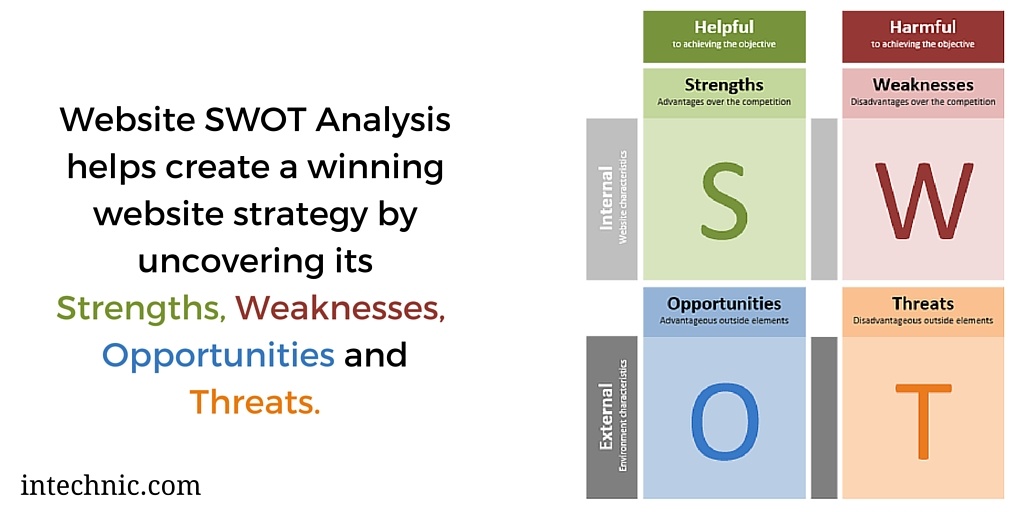
Why is SWOT Analysis important for your website’s success?
The purpose of performing a SWOT Analysis on your website is to discover which characteristics are important to the website’s success and what factors can be potentially harmful. By doing a SWOT Analysis of your company website, you and other decision-makers can better understand your website's strengths and weaknesses and identify external factors that might affect your organization. These findings will be especially helpful to consider when crafting your overall website strategy. 
What does a SWOT Analysis look like?
The basic SWOT Analysis is broken up into four quadrants, each creating part of its acrostic name. The four parts consist of Strengths, Weaknesses, Opportunities and Threats. These quadrants are further categorized into two groups, the internal and external environments. SWOT analyses begin with a structure consisting of an internal and external environment. Each environment group contains a positive category (things that will be beneficial to reaching the business objectives) and a negative category (things that could prevent you from reaching the objectives). These categories contain the characteristics that make up the analysis.
|
Internal
|
Strengths
Characteristics of your website that give you an advantage and help reach objectives.
|
Weaknesses
Website characteristics that present a disadvantage or prevent you from reaching objectives.
|
|
External
|
Opportunities
Elements that the website could use to its advantage to help reach its objectives.
|
Threats
Elements outside of your control that could cause trouble and prevent the website from reaching its business objectives.
|
The first group we will focus on is the internal environment. The internal environment only contains characteristics that directly affect the website or company. The internal environment is broken down into two categories–strengths and weaknesses. Thus, the characteristics listed under strengths and weaknesses should be a part of the website now and should not contain any external factors affecting the website. The second group of a SWOT Analysis is the external environment. The external environment consists of two categories–opportunities and threats. These categories contain characteristics (other than the characteristics of the website itself) that affect the website.
SWOT Analysis: Definitions of internal & external factors
- Internal Environment - within your control such as your website or your company
- External Environment - outside of your control such as the marketplace
How to do a Website SWOT Analysis
To prepare to do your website SWOT Analysis, you first need to reflect on your website goals and determine how the SWOT factors can help or prevent you from reaching your goals. I recommend setting SMART website objectives (and also looking at some website goal examples). After identifying the goals of your own website, hypothesize the purpose of your competitors’ websites. By doing so, you can compare the goals of your company’s website to your competitors’ that have the same goals.
Step 1: Identify internal factors affecting your website
First, go through your Website Customer Interviews, Customer Journey Map and Website Competitive Analysis (you should have completed them beforehand) with green and red markers and mark positive mentions of your website in green and negative attributes in red. Positive attributes are the ones where the website helped customers solve their problems and get them to a solution and negative are the ones where something stood in their way. Pay special attention to anything that stands in the way of users completing their goals in the Customer Journey.
Internal Strengths
Create a strengths list by combining all of the items you marked green into a single list. This list should contain advantages over competitors’ websites that would give your website a competitive edge and help you get to your business objectives more quickly. Website strengths are related to the main goals and objectives of the website’s creation. Here are some examples of common website strengths:
- Customer-centric design and messaging
- Effective calls to action
- Useful and relevant content
- Intuitive navigation and search
- Quick and easy checkout process
- Responsive design with full mobile support
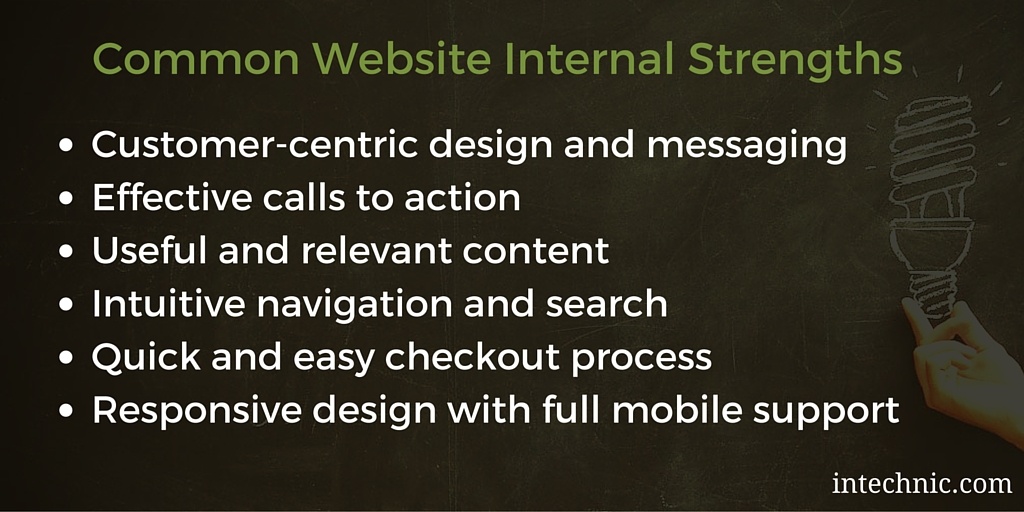
Internal Weaknesses
Weaknesses are simply characteristics of a website that put you at a disadvantage or that can prevent you from reaching your business objectives. Like we did for strengths, create a list of internal characteristics that are weaknesses – but this time, only add the red items. These characteristics can be identified by comparing a better-performing feature/characteristic of a competitor’s website to the same feature on your website. Both websites may have a particular feature or characteristic, but that characteristic is executed better on the competition’s website. Weaknesses do not necessarily have to be a comparison. If a characteristic is outdated or is inadequate for its function, it can be considered a weakness. Here are some examples of typical website weaknesses:
- Outdated or ineffective design
- Ineffective or concealed calls to action
- Content that is not customer-centric
- Confusing structure and navigation
- Cumbersome and lengthy checkout process
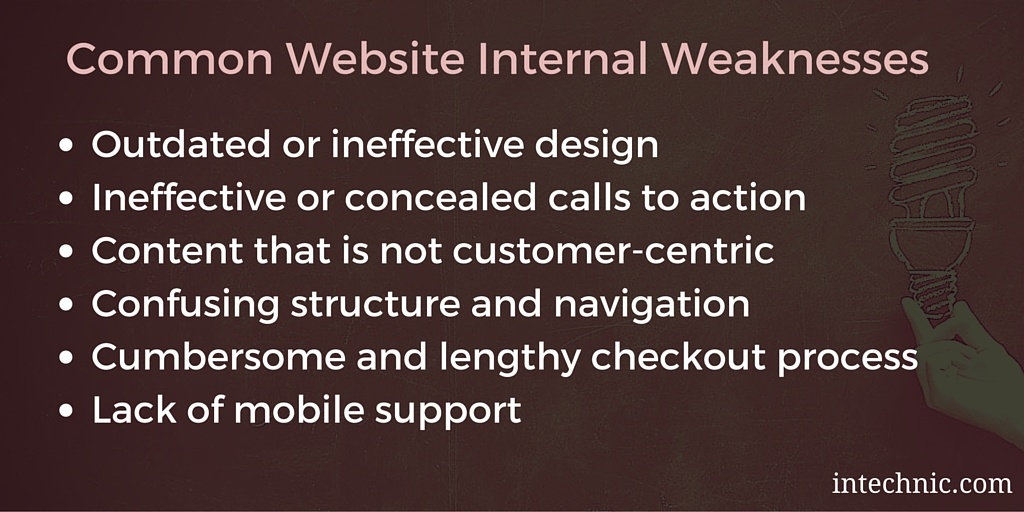
Step 2: Identify external factors affecting your website
Go through the Website Customer Interviews, Customer Journey Map and Website Competitive Analysis one more time with blue and yellow markers. This time look for opportunities - things that the website could do to help customers reach their objectives and help you reach yours (you especially want to focus on things your competitors don’t do, or do badly). Pay special attention to customer “wishes” and mark those in blue. For example: Users want clear feature comparisons (which none of your competitors offer). At the same time, look for threats – elements that are outside of your control that could cause trouble and prevent the website from reaching its business objectives. Mark those in yellow. For example: Many competitors offer solutions very similar to ours. Now, put those in the corresponding columns in your SWOT Analysis table.
External Opportunities
Now create an external opportunities list. On this list should be ways in which your organization can improve performance and its competitive advantage in the market environment. There are some external opportunities that can be predicted, like expanding to new cities or countries. Here are some common examples of website's external opportunities:
- New technologies to improve user experience
- Emerging new and untapped markets
- New niches and market segments
- New design trends to better convey messages
- More effective marketing tactics
- Positive changes in social factors
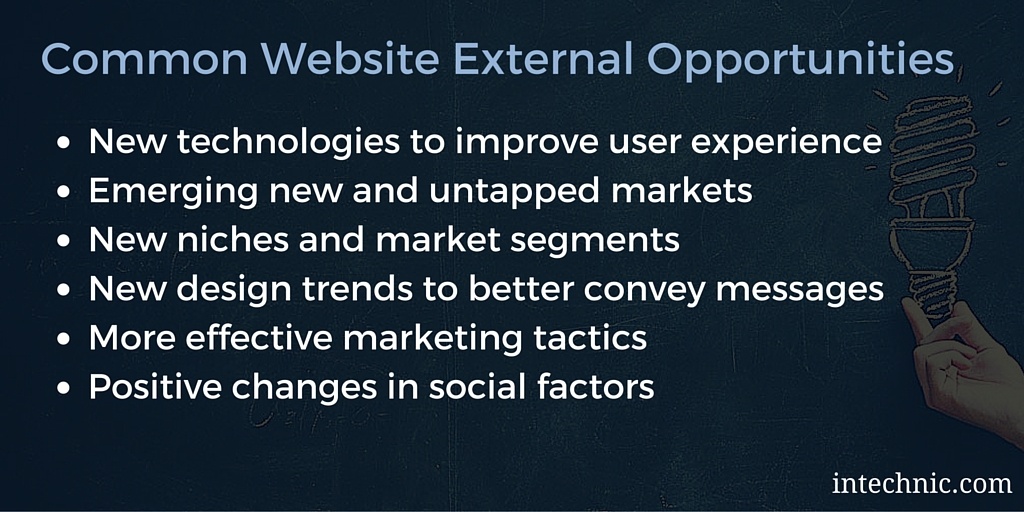
External Threats
Enter your list of threats into the SWOT Analysis template. On this list should be anything that is outside of your control that may prevent you from reaching website’s business objectives. These threats can be certain features that your competitors have that you do not. Threats can also be regulatory or technical. Here are some common examples of external threats to a website:
- Competitors copying features or ideas
- Emergence of new competitors
- SPAM & unsolicited advertising
- Upgraded browser software
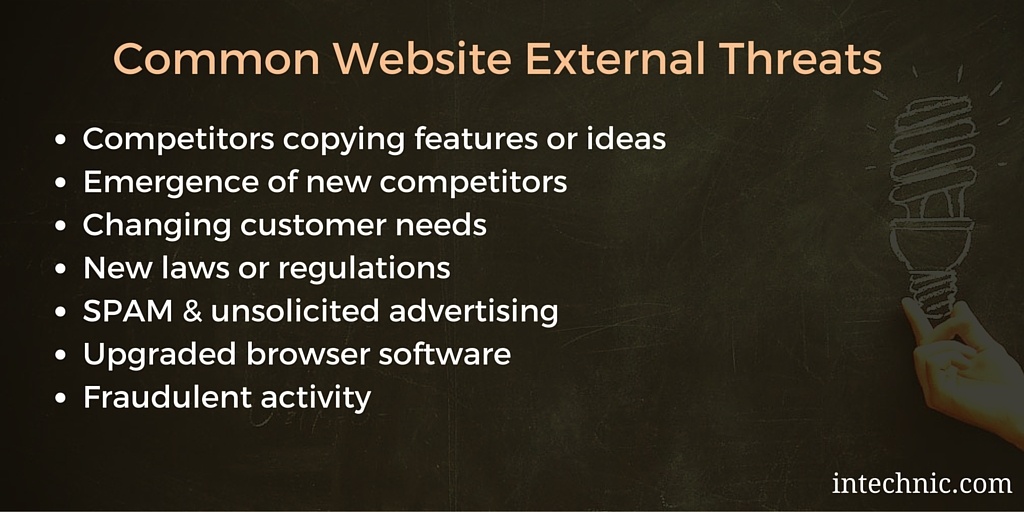
Step 3: Populate SWOT Quadrants
Now transfer the items from your Strengths, Weaknesses, Opportunities and Threats lists into the appropriate quadrant of the Website SWOT Analysis Template (see below). There are two completed Website SWOT Analysis examples that you can use as guides: one for a B2B website and one for a B2C website.
SWOT Analysis Pro Tips
SWOT Analysis Do’s
- Do thoroughly review all available resources to uncover your Strengths, Weaknesses, Opportunities, and Threats.
- Do ask your customer-facing departments (sales, marketing, customer service, etc.) to review your Website SWOT Analysis once you are finished. You want to ensure that you haven’t missed anything.
SWOT Analysis Don’ts
- Don’t allow this to become a laundry list of every factor that could possibly include on your website. Only focus on those factors that will significantly affect your ability to achieve your business goals.
- Don't make things up or resort to findings from prior research and interviews.
- Don’t let this be the last time you conduct a Website SWOT Analysis! You should review this document periodically, especially when your market changes, your company targets new audiences or after you make significant changes to your website.
How can you use the SWOT Analysis to improve your website?
Now that you have characteristics for each of the four quadrants, you can better the performance of the website within your marketplace. Your SWOT Analysis gives an objective view of what characteristics and factors are affecting the website. From this point, you can start working towards reducing the impact of the negative effects and capitalizing on your strengths and opportunities.
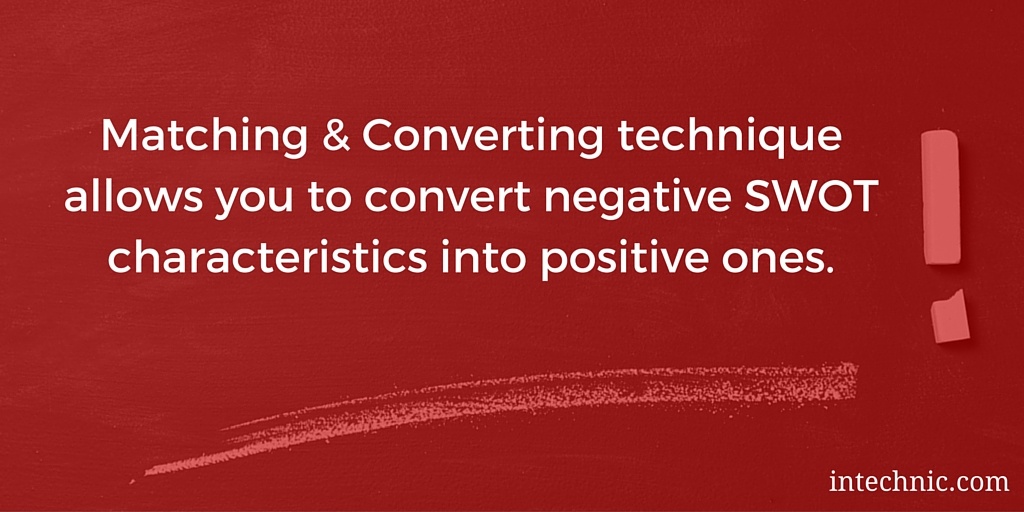
Matching & Converting
In order to limit your site’s weaknesses and threats, you can match or convert those negative characteristics into positive ones. You fight your competitors every day. Either you or your competitor wins based on the particular competitive advantage that you have over the other. Matching is simply mimicking a competitive advantage that your competitor holds. By doing so, you disable your competition’s advantage. Similarly, converting is developing a solution to change a negative characteristic into a positive one. Start by targeting a weakness or threat against your website. Convert this into a positive characteristic by adding a feature to the website that negates the negative characteristic. Download the Website SWOT Analysis Template we use here at Intechnic along with some helpful B2B and B2C Examples:
You just made your website more competitive!
Congratulations, you have successfully completed a SWOT Analysis of your website. Armed with this informative tool, make your website something great! Meet those SMART Objectives you set at the very beginning of your planning process and blow away your competition.
Download: Website SWOT Analysis Template and Examples


